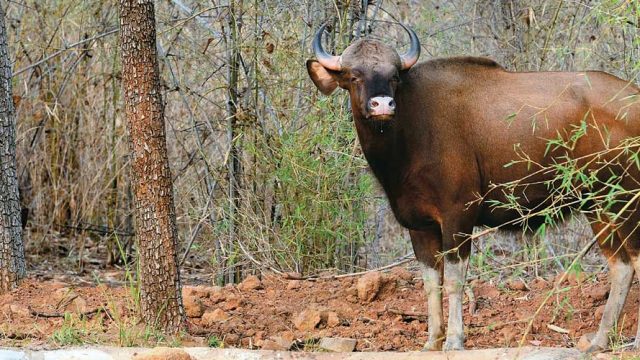Getting in early is the key to this forest reserve. Even the small unusual birds that hop around the government guesthouse precincts disappear after nine in the morning. Similarly, jungle life also begins early, and the animals retire before it gets too hot. If you do not get moving when the light is beginning to seep into the sky, you might end up without a single sighting. Bison point, the most popular lookout point, is a good 25 km in the interior of the reserve, and it takes 2.5 hours of being driven on dirt road tracks to get here.
En route, you might see a paradise fly catcher fly past the jeep’s windows in a rapid flurry of white; a wild rooster dashing before you, panicked by the jeep, almost forgetting it can fly away; clusters of unseen male cicadas fluttering their wings and generating a peculiar buzzing sound, then suddenly switching off in unison. Then again, there are those rare, noiseless stretches in the forest, where fronds of moss hang from anjan trees and bend over the karvi undergrowth. The karvi lives flowerless for six years and in its seventh, dies in a swan song of purple flowers that seem to carpet every inch of the forest floor.
Things to See & Do
Early mornings and late evenings are the best times to visit the sanctuary, which lets visitors in from 6.00am to 6.00pm; make the most of it.

Visitors have the option of either trekking through the long stretches of kuccha road to the heart of the jungle with their guide, or travelling in a jeep. The topography here is ever changing, from thick forest with a dense undergrowth, to open meadows of dry grass and wildflowers on a bed of bauxite, where bison come to graze.
Just a few steps down a forest path the Konkan lies spread out before you. There are layers upon layers of mauve hills, sunlight playing over stretches of green; lakes in the distance and beyond them, more mountains. A small hamlet gleams in the evening sun.
Karud Ghat, Govandsari Kurli Dam reservoir, Dhamni Dam reservoir and Phonda Ghat are some of the popular tourist spots where the vistas are spectacular.
Down in the village of Dajipur is a circular display hall that tells you more about the inhabitants of the forest, has large mounted labelled photographs and interactive quizzes on display, and pug marks of forest inhabitants cast in plaster.
Take a walk down to Sunset Point, a few feet away from the large arch that marks the beginning of the Sindhudurg area, and join the tourists trying to carry home a memory of this place in the form of a photograph.
Laxmi Talao
If you are staying at Radhanagari, it is well worth the visit to climb the few steps up to see those shores of the Laxmi Talao, the reservoir lake of the Radhanagari Dam. There is a cluster of old ruins on an island in the reservoir where Shahuji is said to have occasionally rested.
Where to Stay & Eat
Government guesthouses rule the roost here. Book these at least a week in advance, pick up the permission letter from the respective Kolhapur office and re-confirm before you start. The PWD Rest House (Kolhapur Tel: 0231-2650042, Fax: 2650140; Tariff: ₹ 250 per person) offers two rooms. For reservations, write/ fax to C/o Executive Engineer, South PWD, Kolhapur. The Irrigation Department’s Inspection Bungalow (Kolhapur Tel: 0231-2654736, Fax: 2654735; Tariff: ₹ 200–250 per person), near the Radhanagari Dam, has two VIP suites and two ordinary rooms. For reservations, write/ fax to C/o Executive Engineer, Kolhapur Irrigation Division, Sinchan Bhavan, Kolhapur. The Dajipur Forest Guest House (Kolhapur Telefax: 0231- 2542766; Tariff: ₹ 500 per person, tents Rs. 1,200) is located closest to the forest reserve. It has one room and 3 tents. There is no provision for food. For reservations, write/ fax to Chief Conservator of Forests, Kolhapur.
Another option is Ekant Homestay (Tel: 08888336668; Tariff: ₹ 2,500–5,000, per person, with meals), near the sanctuary, serve vegetarian and non-vegetarian food, and all meals are included in the tariff.
The government rest houses offer good, basic meals. At Dajipur, where the guesthouse does not offer food, there are two small and simple eating joints within easy walking distance: the Bison Resort Hotel and Bapucha Hotel at Sunset Point.
Fast Facts |
When to go The sanctuary is closed between June and October. November-December has fine weather. It can get really hot, really chilly and really wet, in different seasons. Be prepared for November rains. April is hot, but good for animal sightings |
Tourist Office |
MTDC Kolhapur Region Desh Location On Phonda Ghat, near the backwaters of the Radhanagari Dam Distance 284 km S of Pune Route from Pune NH4 via Kolhapur |
Getting There |
Air Nearest airport: Belgaum (150 km/2.5 hrs). Taxi costs about ₹ 3,000 |
Rail Nearest railhead: Kankavli (54 km/1 hr). Take a jeep for ₹ 1,500 to Dajipur |
Road NH17 to Tarele via Chiplun and Rajapur. Turn left at Tarele for Phonda Ghat, 18 km away. Dajipur is 12 km from here. You can also drive down via Pune and Kolhapur. |
Bus From Parel ST Stand in Mumbai at 7.00am and 8.45am for Radhanagari Wildlife Sanctuary daily (14 hrs’ journey). Better connections to Kolhapur |
TIP Not advised for a short weekend |




